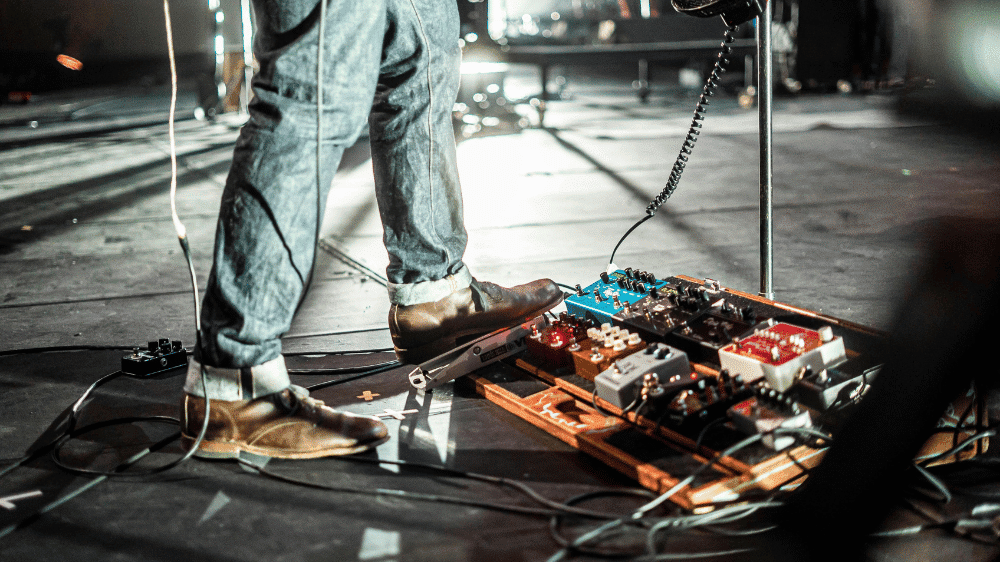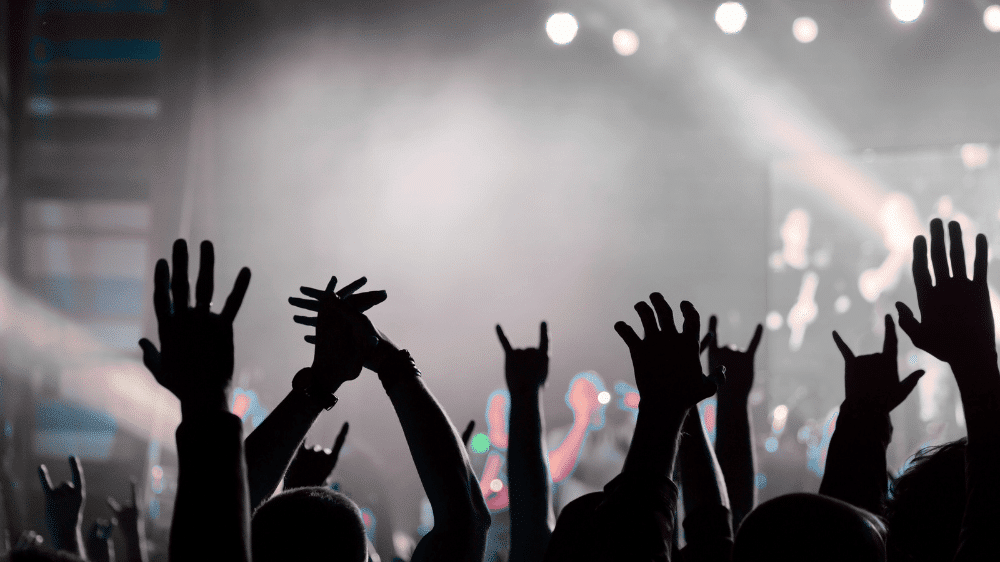Finding the perfect guitar tone can feel impossible when you’re stuck with muddy bass frequencies or harsh treble that cuts through the mix for all the wrong reasons. You’ve probably tweaked your amp’s EQ knobs endlessly, only to discover they don’t give you the precise control you need.
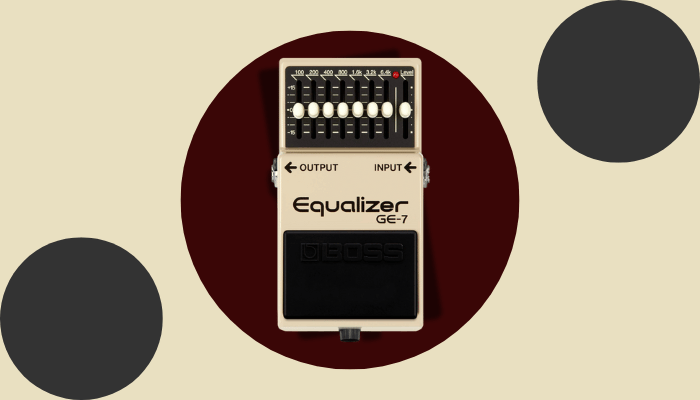
The solution isn’t buying a new amp or guitar – it’s understanding how an EQ pedal can transform your existing setup into a tone-shaping powerhouse.
After years of experimenting with different EQ configurations and helping countless guitarists dial in their sound, I’ve learned that most players underestimate just how much control a simple EQ pedal can provide. The difference between a good tone and a great tone often comes down to precise frequency adjustments that only a dedicated equalizer can deliver.
In this guide, I’ll break down exactly what EQ pedals do, how they work, and give you a clear framework for choosing and using one effectively in your setup.
Key Takeaways
- An EQ pedal gives you precise frequency control beyond your amp’s basic tone knobs. Think surgical precision vs broad adjustments.
- Main uses: Fix muddy or harsh tones, boost solos to cut through the mix, and adapt your sound to different rooms and venues.
- You probably need one if: Your amp sounds great at home but terrible live, you play multiple guitars through the same amp, or you’re fighting specific frequency problems.
- Quick starter tip: Cut 100-300Hz to reduce muddiness, boost 800Hz-1.6kHz to make solos pop.
Table of Contents
What Is an EQ Pedal?
An EQ pedal (short for equalization pedal) is a guitar effect that allows you to boost or cut specific frequency ranges in your signal. Think of it as a more precise, powerful version of the treble, middle, and bass knobs on your amplifier.
While your amp’s EQ controls give you broad tonal adjustments, a guitar EQ pedal provides surgical precision. You can target exact frequency ranges that might be causing problems or enhance specific characteristics that make your guitar sing.
Here’s the key difference:
Your amp’s EQ typically affects three broad frequency ranges, while most EQ pedals give you control over 3-10 specific frequency bands. This means you can boost the exact frequencies that add punch to your solos without affecting the frequencies that might muddy up your rhythm playing.
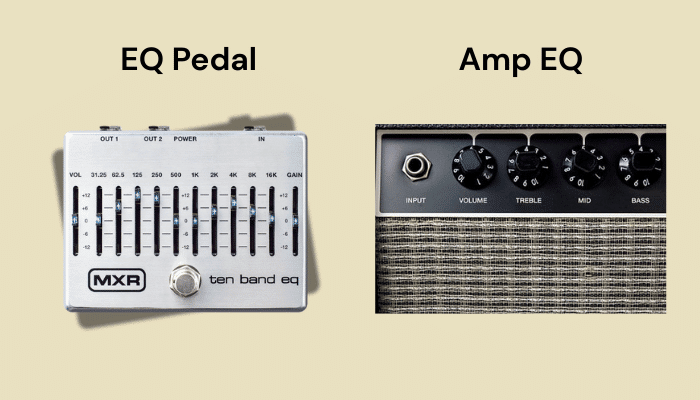
How Do EQ Pedals Work?
To understand how an EQ pedal works, explained in simple terms, comes down to frequency manipulation. Your guitar produces a complex mix of frequencies when you play. From the deep fundamental notes of your low E string to the bright harmonics that give your tone character.
An EQ pedal intercepts this signal and allows you to:
- Boost frequencies by up to +15dB or more
- Cut frequencies by up to -15dB or more
- Leave frequencies unchanged at the center position
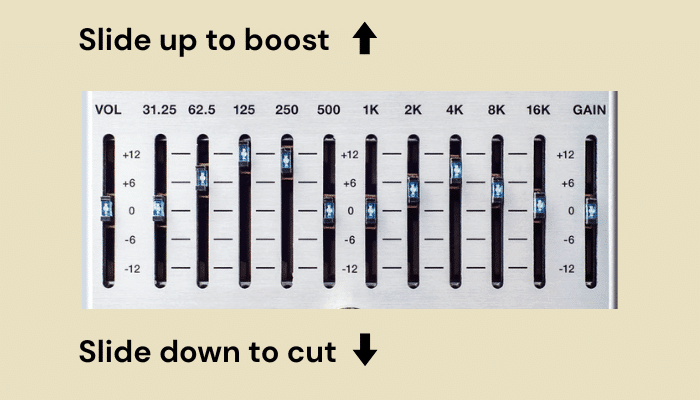
The Two Main Types of EQ Pedals
Graphic EQ Pedals
Graphic EQ pedals feature multiple sliders, each controlling a fixed frequency band. A 6-band EQ pedal might have sliders at 100Hz, 200Hz, 400Hz, 800Hz, 1.6kHz, and 3.2kHz. The MXR EQ pedal 6-band is a classic example that many guitarists swear by.
The visual layout makes it easy to see your EQ curve at a glance. When you boost the 800Hz slider, you can literally see that you’re adding midrange punch to your tone.
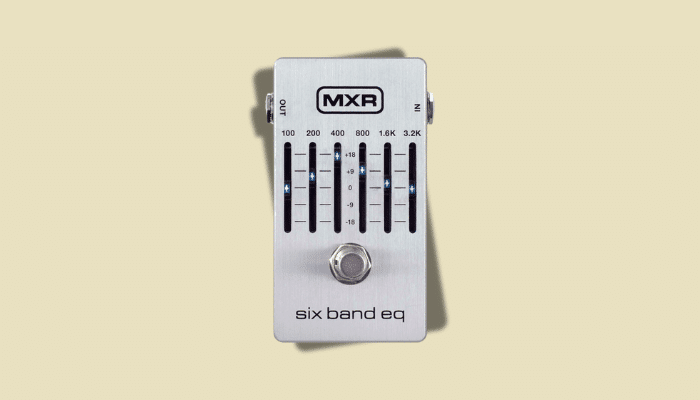
Parametric EQ Pedals
A guitar parametric EQ pedal gives you more precise control. Instead of fixed frequency bands, you can:
- Choose the exact center frequency you want to adjust
- Control how wide or narrow the frequency band affects (called “Q”)
- Boost or cut by specific amounts
Using a parametric EQ pedal for guitar setups works exceptionally well when you know exactly which frequency is causing problems. If you have a resonant frequency at 2.3kHz that’s making your amp feedback, a parametric EQ can target that exact frequency without affecting nearby frequencies.
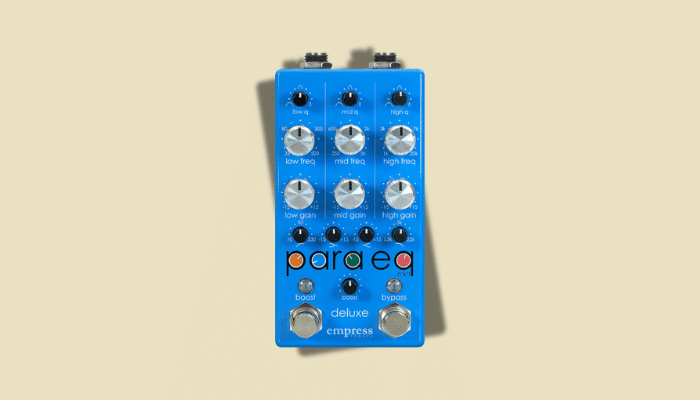
What Does an EQ Pedal Do? The Practical Applications
Now that you understand the basics, let’s explore the real-world applications that make EQ pedals indispensable for many guitarists. Whether you’re chasing specific genre sounds, solving tonal problems, or adapting to different playing situations, here’s how to put your EQ pedal to work.
Tone Shaping for Different Musical Styles
Classic Rock Tones
For vintage rock sounds, try boosting around 800Hz-1kHz for midrange growl while slightly cutting the 2-3kHz range to tame harshness. Many classic rock guitarists used this approach to get sustain without shrillness.
Modern Metal Tones
Metal players often prefer the “scooped” sound – cutting midrange frequencies around 400-800Hz while boosting bass (100-200Hz) and treble (3-5kHz). However, don’t scoop too aggressively, or your guitar will disappear in the mix during live performance.
Clean Jazz and Blues Tones
For pristine clean tones, subtle adjustments work best. A slight boost around 1-2kHz can add presence, while cutting any muddy frequencies below 100Hz keeps your tone clear and defined.
Problem-Solving Applications
Fixing a Muddy Amp
Does your amp sound cloudy or undefined? Cut frequencies between 80-200Hz to tighten up your low end. Many guitarists are surprised how much clarity this simple adjustment provides.
Taming Harsh Treble
If your amp sounds icepick-sharp, cut frequencies around 3-5kHz. Start with small cuts – even 2-3dB can transform a harsh tone into something pleasant.
Adding Solo Boost
An EQ pedal as boost works differently than a traditional overdrive pedal. Instead of adding distortion, you can boost midrange frequencies (800Hz-1.6kHz) to help your solos cut through the band mix without changing your core tone.
Acoustic Guitar Applications
An acoustic guitar EQ pedal serves different purposes than electric guitar EQ. Acoustic pickups often emphasize certain frequencies that don’t sound natural. Common adjustments include:
- Cutting the 2-3kHz range to reduce piezo pickup harshness
- Boosting 100-200Hz to restore body that pickups often lose
- Slight treble boost around 5-8kHz for sparkle and presence
Do I Need an EQ Pedal? When EQ Pedals Make the Biggest Difference
The honest answer: not every guitarist needs an EQ pedal. But if you’re experiencing specific tonal challenges, an EQ pedal might be exactly what you’re missing.
You Probably Need an EQ Pedal If:

- Your amp sounds great at home, but terrible at gigs
Different rooms emphasize different frequencies. An EQ pedal lets you adapt your tone to any venue quickly. I’ve seen guitarists transform their live sound instantly by cutting the frequencies their amp was fighting against. - You play multiple guitars through the same amp
A Telecaster and a Les Paul sound completely different through the same amplifier. An EQ pedal lets you compensate for these differences, making both guitars sound their best without changing amp settings. - You need more tonal control than your amp provides
Many great-sounding amps have limited EQ options. Vintage Fender amps might only have treble and bass controls. An EQ pedal gives you the midrange control these amps lack. - You’re fighting feedback at specific frequencies
If your setup feeds back at particular frequencies, an EQ pedal can surgically remove those problem frequencies without affecting your overall tone.
You Might Not Need an EQ Pedal If:
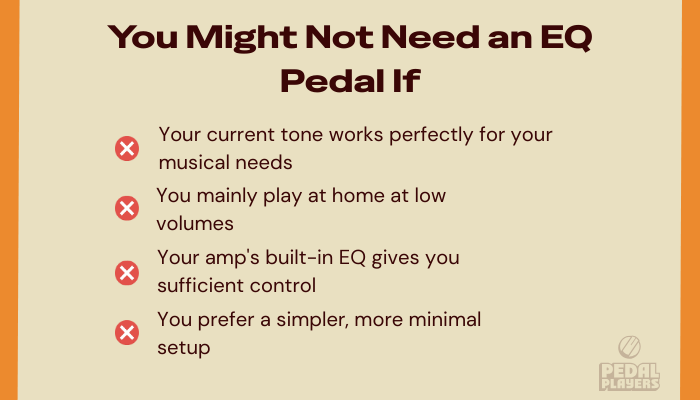
- Your current tone works perfectly for your musical needs
- You mainly play at home at low volumes
- Your amp’s built-in EQ gives you sufficient control
- You prefer a simpler, more minimal setup
Where to Put an EQ Pedal in the Chain
Where to put the EQ pedal in the signal chain depends on what you’re trying to achieve. EQ placement dramatically affects how it interacts with other pedals and your amp.
Before Distortion/Overdrive Pedals
Placing your EQ pedal early in the chain lets you shape what frequencies hit your distortion pedals. This approach:
- Affects how your distortion pedals respond and compress
- Can reduce muddiness by cutting bass before it hits overdrive
- Helps prevent feedback-prone frequencies from getting amplified
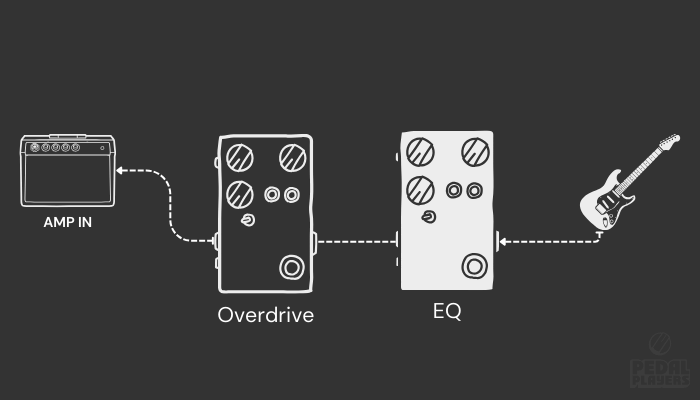
After Distortion/Overdrive Pedals
Post-distortion EQ placement gives you more traditional “tone shaping” control:
- Shapes your final distorted tone
- Better for general tone adjustments
- Easier to hear exactly what you’re changing
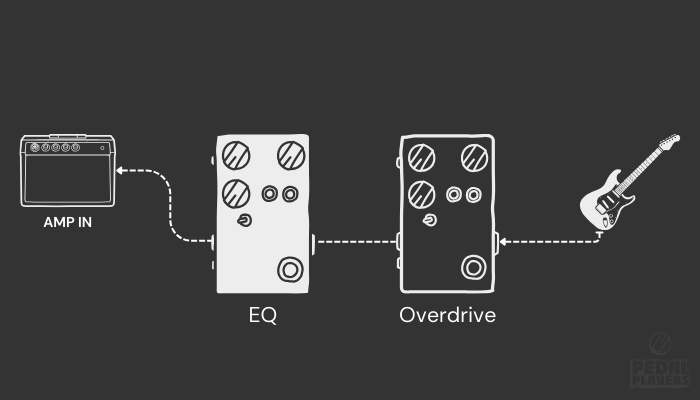
In Your Amp’s Effects Loop
If your amp has an effects loop, placing your EQ pedal there gives you control over your power amp and speaker response. This placement works especially well for:
- EQ pedal as preamp tone shaping
- Correcting room acoustics issues
- Fine-tuning your overall sound without affecting your pedal chain
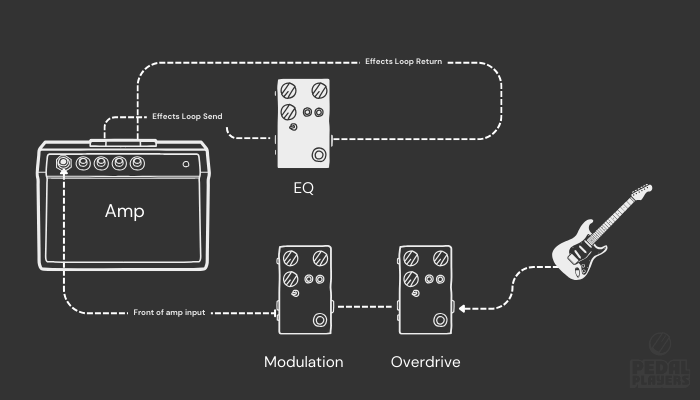
EQ Pedal vs Amp EQ: Understanding the Difference
Many guitarists wonder why they need an EQ pedal when their amp already has tone controls. Here’s the practical difference:
Amp EQ typically controls:
- 3-4 broad frequency ranges
- Fixed center frequencies
- Limited boost/cut range
EQ Pedal typically controls:
- 3-10+ specific frequency bands
- More precise frequency selection
- Greater boost/cut range (+/- 15dB or more)
Your amp’s EQ is like adjusting tone with a paint roller. An EQ pedal is like using a fine brush – much more precision for detailed work.
Types of EQ Pedals: Choosing the Right One
3-Band EQ Pedals
A 3 band eq pedal offers simple bass, midrange, and treble control. These work well for:
- Basic tone shaping
- Simple boost applications
- Guitarists who want EQ without complexity
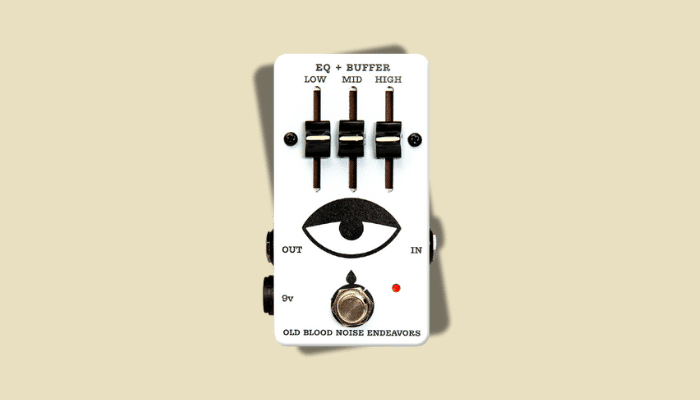
6-Band and Higher
Six-band and higher EQ pedals provide more precise control. They’re ideal for:
- Problem-solving specific frequency issues
- Professional live performance
- Studio recording applications
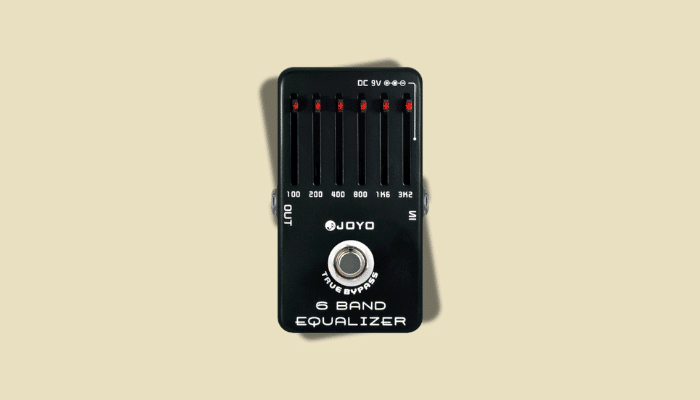
Specialized EQ Pedals
Some EQ pedals combine equalization with other functions:
- EQ compressor pedal combinations provide both tone shaping and dynamic control
- EQ pedal for bass applications with frequencies optimized for bass guitar
- Preamp EQ pedals that combine gain staging with tone control
Practical EQ Pedal Settings to Try
General Starting Points
For Single-Coil Pickups (Strat, Tele):
- Slight boost around 100-200Hz for body
- Small boost around 1-2kHz for presence
- Cut any harsh frequencies around 3-4kHz if needed
For Humbuckers (Les Paul, SG):
- Sometimes benefit from treble boost around 3-5kHz
- May need slight cut around 500Hz if too thick
- Adjust based on your specific pickups
For Live Performance:
- Cut frequencies below 80Hz to reduce stage rumble
- Boost midrange slightly (800Hz-1.6kHz) to cut through the mix
- Be conservative with treble boost – it can become harsh through PA systems
Quick Problem-Solving Settings
- Too Muddy: Cut 100-300Hz
- Too Harsh: Cut 3-5kHz
Not Enough Punch: Boost 800Hz-1.6kHz - Getting Lost in the Mix: Boost 1-3kHz range
- Too Boomy: Cut 80-150Hz
Remember: Start with small adjustments (2-3dB) and use your ears, not your eyes.
Is an EQ Pedal Worth It? The Bottom Line
After many years of helping guitarists improve their tone, I can say that an EQ pedal is worth it if you’re experiencing specific tonal challenges that your current setup can’t address.
An EQ pedal becomes invaluable when you need:
- Precise frequency control beyond your amp’s capabilities
- Adaptability for different venues and situations
- Problem-solving tools for feedback or tonal issues
- The ability to optimize multiple guitars through the same amp
Start with identifying your specific tonal goals. Do you need more midrange punch for solos? Are you fighting muddy low end? Is your tone too harsh for certain songs?
Once you know what you’re trying to achieve, an EQ pedal gives you the surgical precision to get there. Your ears and your specific setup will guide you to the best solution for your sound.
The key insight: an EQ pedal isn’t about following rigid rules. It’s about giving you the tools to shape your tone exactly how you hear it in your head. With practice and experimentation, you’ll develop the skills to use EQ effectively, transforming good tones into great ones.
FAQs
Is an EQ pedal worth it for beginner guitarists?
Yes, an EQ pedal can be especially valuable for beginners who are still learning to dial in their amp settings. Many beginner amps have limited tone controls, and an EQ pedal provides the precision needed to fix common tonal issues like muddiness or harshness. However, focus on learning your amp’s basic controls first before adding an EQ pedal to your setup.
What’s the difference between an EQ pedal and a boost pedal?
While both can increase your signal level, an EQ pedal as boost gives you frequency-specific control. A traditional boost pedal raises your entire signal equally across all frequencies, while an EQ pedal lets you boost only the midrange frequencies (around 800Hz-1.6kHz) that help solos cut through the mix without adding unwanted bass or treble.
Can I use an EQ pedal for bass guitar?
Absolutely. An EQ pedal for bass works similarly to guitar applications but targets different frequency ranges. Bass players typically focus on 40-100Hz for deep low end, 100-300Hz for punch, and 1-3kHz for attack and clarity. Many EQ pedals work well for both instruments, though some are specifically designed with bass-optimized frequency ranges.
Should I get a parametric or graphic EQ pedal?
Graphic EQ pedals (like the popular MXR EQ pedal 6 band) are more intuitive for beginners and general tone shaping. Parametric EQ pedals offer more precision if you need to target specific problem frequencies. If you’re just starting with EQ, a graphic EQ is usually easier to understand and use effectively.
Where should I place my EQ pedal in my effects chain?
Where to put EQ pedal in chain depends on your goals. Place it before distortion/overdrive to shape what frequencies hit those pedals, or after distortion for general tone shaping. For overall tone control, try placing it in your amp’s effects loop if available. Experiment with different positions to hear how each placement affects your sound.
What’s the difference between an EQ pedal and my amp’s EQ?
EQ pedal vs amp EQ comes down to precision and flexibility. Your amp’s EQ typically controls 3-4 broad frequency ranges at fixed points, while an EQ pedal offers 3-10+ specific frequency bands with greater boost/cut range. Think of amp EQ as general tone shaping and pedal EQ as surgical precision for problem-solving.
Do I need an EQ pedal if I already have a good amp?
Even great amps can benefit from an EQ pedal. Do I need an EQ pedal depends on whether you face challenges like room acoustics, multiple guitars sounding different through the same amp, or needing more precise tone control than your amp provides. If your current setup handles all your tonal needs, an EQ pedal might be unnecessary.








